Self-propelled gun mount 15 cm sIG 33 (SF) auf Pz.Kpfw.38 (t) Ausf.Н Grille (Germany)
In early March 1942, the command determined the future prospects of the available lungs. tanks Pz.Kpfw. 38 (t) Czechoslovak production. The use of this equipment in its original form was already in doubt due to obsolescence, because of which it began to be considered as a promising basis for new combat vehicles, primarily self-propelled artillery installations. After some modifications, it was proposed to install various types of artillery guns on tank chassis. One of the options for such modernization of tanks implied the use of 15 cm sIG 33 guns.
The development of new armored vehicles based on Pz.Kpfw.38 (t) was entrusted to several organizations, including Böhmisch-Mährische Maschinenfabrik AG (now ČKD), one of the main manufacturers of such tanks. Having received the terms of reference for a new project, BMM experts have begun to adapt the existing combat vehicle for new weapons. It was decided to use some of the proven ideas and technical solutions, which allowed to speed up the development of the project, as well as simplify the production of serial equipment. In fact, it was planned to only slightly change the design of the case, as well as equip it with a set of new equipment. Other units were suggested to be used without changes.
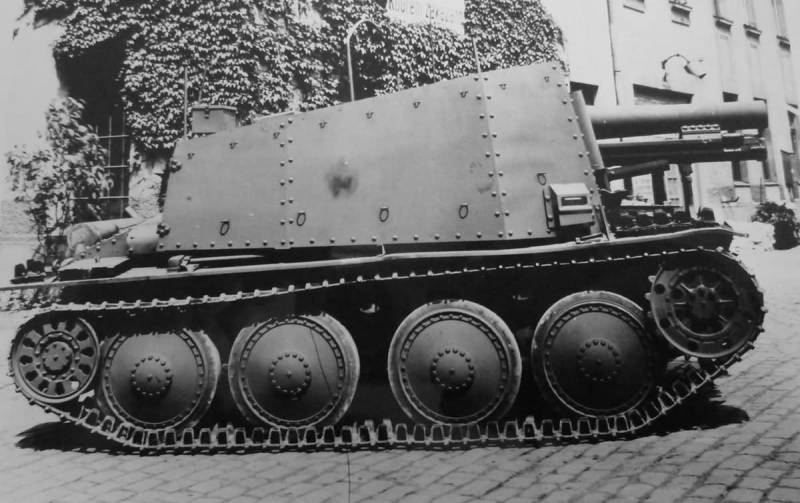
One of the earliest examples of 15 cm sIG 33 (SF) auf Pz.Kpfw.38 (t) Ausf.N. Photo Worldwarphotos.info
Perspective ACS with sIG 33 cannon received the symbol 15 cm sIG 33 (SF) auf Pz.Kpfw.38 (t), reflecting the main components of the machine. In addition, over time, the project received an additional name Grille ("Cricket"). It should be noted that in the course of further modernization of the self-propelled gun, a new machine of the same name appeared with other design features and other characteristics. This feature of the development of ACS based on Czechoslovak tanks can be confusing.
The first version of self-propelled guns based on Pz.Kpfw.38 (t) implied minimal changes to the base chassis while retaining its features. So, it was proposed to remove the existing tower from the tank, as well as remove the turret box and rework the hull roof structure. At the same time, it was planned to keep the existing lower part of the hull, as well as the internal units, undercarriage, etc. On the modified roof should have been located a new armored cabin with a weapon. The layout of the hull, despite all the changes, generally remained the same: the transmission and control compartment in the front, the combat compartment in the center and the engine compartment in the stern.
The lower part of the hull of the new ACS was supposed to go into a promising project without any changes. She kept the frontal part, consisting of several armor plates with a thickness of up to 25 mm, located at different angles to the vertical. In addition, in order to increase the level of protection, it was proposed to install additional sheets bringing the frontal armor thickness to 50 mm. The sides still had to be 15 mm thick, and the stern should have been made from 10-mm sheets. The roof and the bottom kept the thickness 8 mm.
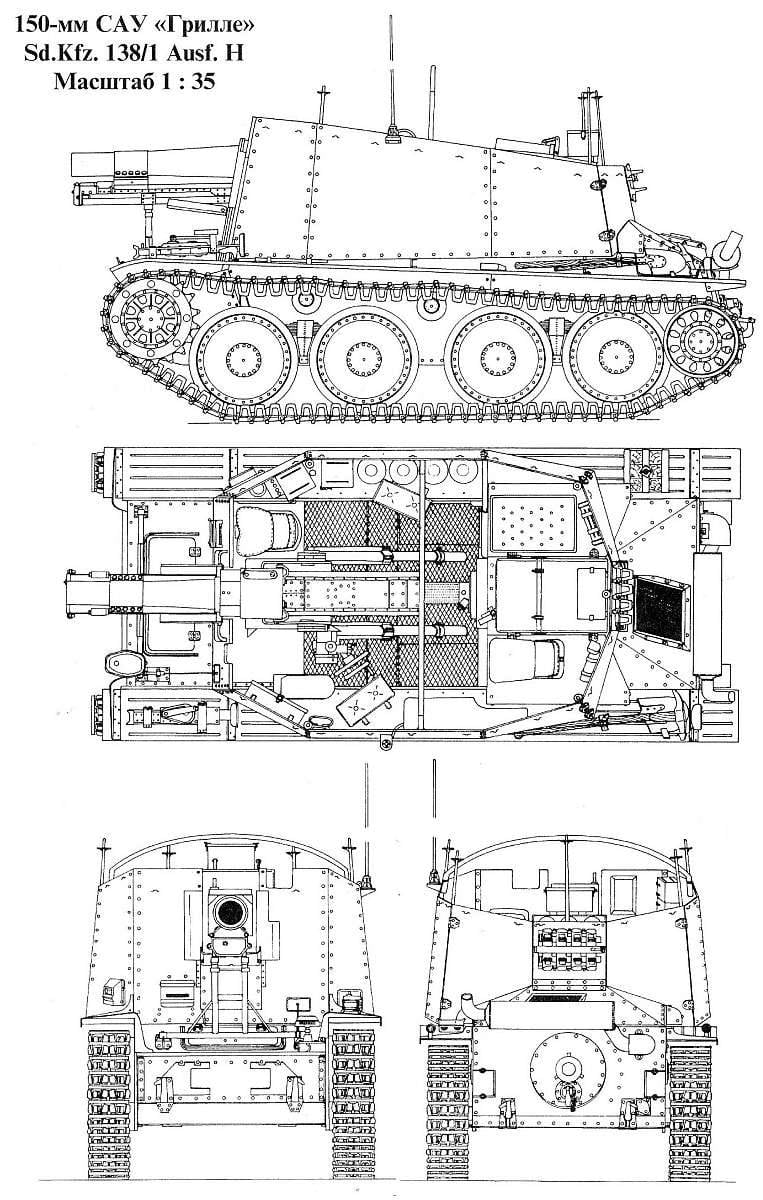
Scheme self-propelled guns. Figure Aviarmor.net
On the roof of the hull, a new project proposed to install a large wheelhouse of a characteristic faceted shape. Above the workplace of the driver should have a sloping frontal sheet, the sides of it were joined with the inside of the cheekbones set at an angle to the machine axis. Also included were boards with beveled back sheets and feed with a notch in the upper part. The cutting was proposed to be made of armor 15 mm thick.
At the rear of the hull, it was planned to keep the Praga EPA / 3 six-cylinder carburetor engine with 125 horsepower. With the engine using a propeller shaft, passing along the body, the mechanical transmission on the basis of a six-speed gearbox was connected. Like the other armored vehicles in service with the German army, the Pz.Kpfw.38 (t) tank had front-wheel drive wheels.
The undercarriage of the base machine was kept completely. It was based on four large diameter skating rinks on each side. The rollers were blocked in pairs and fitted with leaf springs. Despite the large diameter of the rollers, additional supporting rollers were included in the running gear. Driving wheels were placed in the front of the hull, guides - in the stern.
The main difference between the promising self-propelled gun from the base tank was the presence of a new combat compartment. In order to increase the habitable volumes, it was decided to use a relatively large and long cabin, the stern of which was placed above the engine compartment. In front of the cabin, the installation of the gun should have been installed, and various auxiliary units, primarily racks for ammunition, should be placed along the sides and at the stern of the fighting compartment.
The basic one weapons The Cricket ACS should have become a heavy sIG 33 field gun of 150 mm caliber. This system during the previous battles managed to show its best. High firepower combined with the power of relatively heavy ammunition made it possible to effectively deal with manpower, equipment and fortifications of the enemy. Moreover, the comparatively high efficiency of the sIG 33 cannon caused several self-propelled guns, including 15 cm sIG 33 (SF) auf Pz.Kpfw.38 (t).
The sIG 33 cannon was equipped with a 11 barrel with calibers of length, a horizontal slide gate and hydropneumatic recoil devices. Used separate loading, could use several types of shells for various purposes. The basis of the ammunition in this case were supposed to be high-explosive fragmentation shells of several types. The maximum initial velocity of the projectile was 240 m / s, which allowed firing at ranges up to 4,7 km.
The installation systems of the gun made it possible to produce horizontal and vertical guidance using hand drives. Horizontal guidance was carried out within a sector of width 10 °, vertical - from -3 ° to + 72 °. As in the case of the basic towed version, the gun was equipped with an Rblf36 sight.
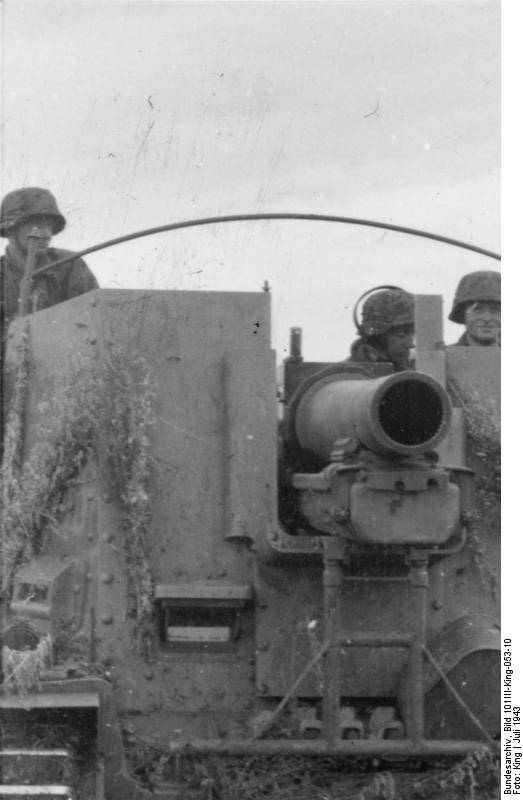
Gun mount. Photo of Wikimedia Commons
Due to the limitations imposed by the dimensions of the machine and the carrying capacity of the chassis, the new ACS should have been distinguished by a small amount of ammunition. Inside the cabin, it was possible to place racks only on 15 shells of separate loading. In this part of the ammunition was placed in a rigid metal holders, while others were proposed to be transported in special textile bags. For a long shooting machine needed the help of a carrier of ammunition.
For self-defense, the Grille SAU crew was asked to use the MG 7,92 34-mm machine gun. As in the case of some other German projects self-propelled guns of the time, the machine gun could not be transported on a special installation in combat status. This weapon and ammunition for him should be transported in the packing of the fighting compartment and removed if necessary.
The crew of self-propelled gun 15 cm sIG 33 (SF) auf Pz.Kpfw.38 (t) was to consist of four people. In front of the hull, in his old place on the starboard side, fit the driver. The commander-gunner was located to the left of the gun. Behind him, on both sides of the weapons, the positions of two loaders were envisaged. One of the loaders also had to perform the duties of a radio operator and use a radio station like FuG 15.
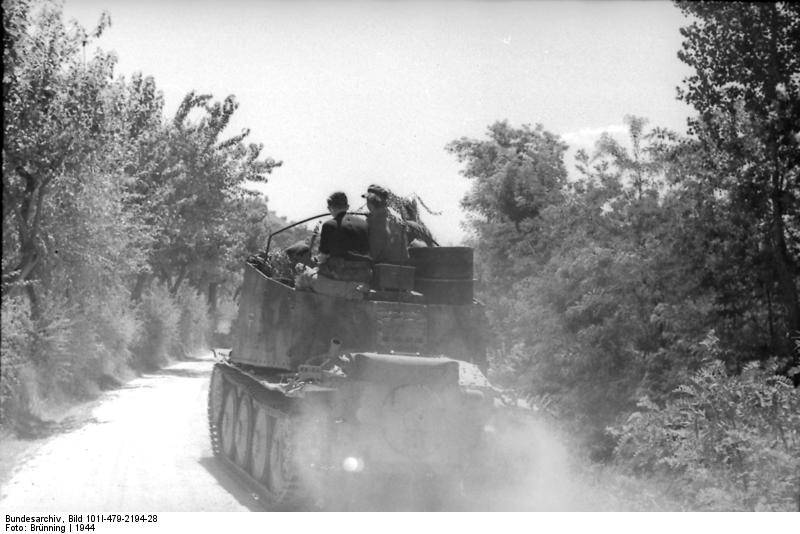
At the front, 1944. Photo by Wikimedia Commons
The absence of major changes in the design of the chassis led to the preservation of basic dimensions. The 15 ACU cm sIG 33 (SF) auf Pz.Kpfw.38 (t) should have a length of the order of 4,6 m, width 2,16 m and height 2,4 m. The combat weight was determined at the level of 11,5 t. The weight increase compared to the base tank should lead to some impairment of mobility. So, with a specific power not more than 10,8 hp per ton the self-propelled gun could accelerate only to 35 km / h and have a power reserve of no more than 185 km.
The development of the new project was completed at the very beginning of 1943. In February, BMM assembled the first prototype of Cricket and presented it for testing. The upgraded chassis of the tank Pz.Kpfw.38 (t) was used as the basis for the new self-propelled gun, as a result of which the experimental machine was designated 15 cm sIG 33 (SF) auf Pz.Kpfw.38 (t) Ausf.H, which reflected this upgrade. To simplify this option machines are sometimes referred to as Grille Ausf.H. It should be noted that this designation allows us to distinguish the first version of ACS Grille from the subsequent developments in this direction.
After some trials, the command approved the serial production of new self-propelled guns. The construction of 200 machines was ordered. At the same time, due to the completion of the serial production of Pz.Kpfw.38 (t) tanks, it was proposed to assemble new equipment during the repair and modernization of existing machines. Front light tanks entering the rear to undergo repairs had to be rebuilt and become carriers of 150-mm guns. It was assumed that this would allow to extend the life of the equipment, which is already morally obsolete and cannot fully solve its tasks in its original form, although it has not yet had time to develop a resource.
By the end of February, 1943, BMM began repairing light tanks arriving from the front and then re-equipping them with a new design. The comparative simplicity of the project had a positive effect on the pace of order fulfillment: according to some information, two dozen self-propelled guns were handed over to the customer by early March. During March, 40 machines were assembled and sent to the army, and in April, another 25. After this, the production of "Crickets" of the first version ceased. In total, 90 vehicles armed with sIG 33 guns were assembled in a few months.
Interestingly, some sources mention the release of the order 200 SAU Grille Ausf.H. Apparently, in this case there is confusion associated with the use of similar notation. As far as we know, already in April, the new version of the 43-1 ACS version “H” was replaced in series production. It is the production and supply of these machines that allow us to “get” the amount of equipment to the required two hundred.
15 cm sIG 33 (SF) auf Pz.Kpfw.38 (t) Ausf.Н Grille self-propelled guns were distributed between the mouths of heavy infantry guns from various divisions. The task of this equipment and its crews was to support the advance of infantry and tanks by attacking remote targets of the enemy, primarily various fortifications. This tactic of using large-caliber self-propelled artillery has already been tested in previous battles, in which sIG 33 carriers of previous models participated, and it proved itself quite well.
Appearing on the front in the spring of the year 1943, self-propelled guns Grille Ausf.H took part in the battles on the Eastern Front. Until a certain time, such a technique was used only in battles with the Red Army. After the outbreak of hostilities in Western Europe, part of the units armed with such self-propelled guns, was transferred to the new theater of operations.
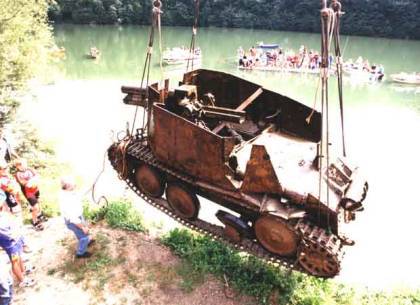
The remains of the SAU Grille Ausf.H, discovered in the late nineties. Photos of Warrelics.eu
The 150-mm gun was a serious means of supporting the advancing troops, but at the same time, self-propelled guns were at serious risk. The enemy tried as quickly as possible to bring such equipment down, which, among other things, contributed to its low level of protection. As a result, heavy infantry company companies regularly suffered casualties. The equipment was destroyed, damaged without the possibility of restoration, or was delivered to the enemy as trophies.
All this ultimately led to the fact that at the time of the surrender, Germany had, according to various sources, only a few self-propelled guns of the type 15 cm sIG 33 (SF) auf Pz.Kpfw.38 (t) Ausf.N. Others for one reason or another were disabled. In the future, and remaining in the presence of cars ceased to exist. Unfortunately, historians and lovers of military equipment, such self-propelled guns did not manage to become museum pieces.
Project 15 cm sIG 33 (SF) auf Pz.Kpfw.38 (t) Ausf.N can be considered as another breakthrough in the creation of self-propelled carriers for 15 cm sIG 33 guns. After several projects that were not very successful in terms of production volumes, the German industry was able to organize the mass construction of the required equipment. In addition, the problem of using outdated tanks, which had not yet managed to develop a resource, but could no longer be used in the original quality, was solved. Soon after the completion of the design work on the ACS Grille Ausf.H, BMM and related organizations began to develop this technology. The result was the emergence of a new self-propelled 15 cm sIG 33 (SF) auf Pz.Kpfw.38 (t) Ausf.M.
Based on:
http://achtungpanzer.com/
http://aviarmor.net/
http://worldwarphotos.info/
http://ww2-weapons.com/
Chamberlain P., Doyle H. Complete reference book of German tanks and self-propelled guns of the Second World War. - M .: AST: Astrel, 2008.
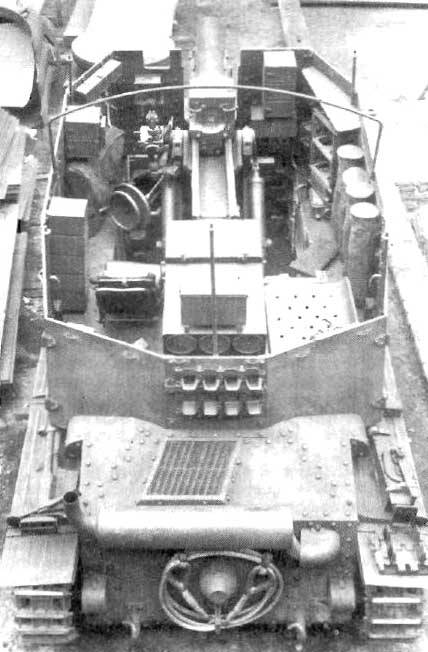
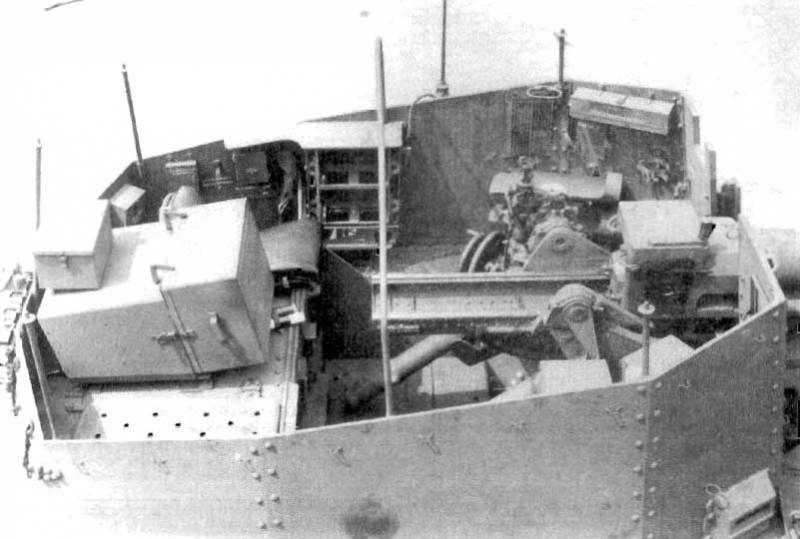
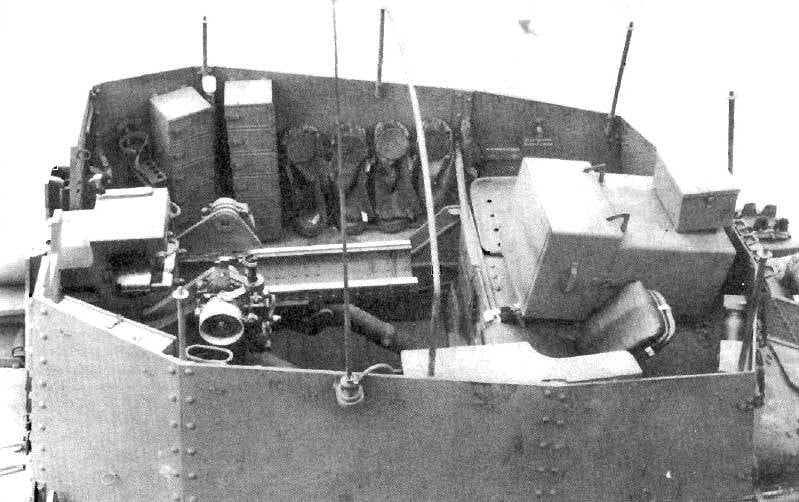
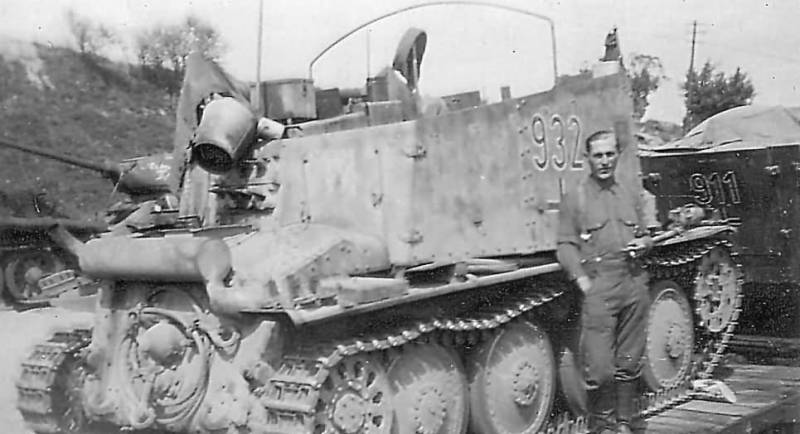
Information